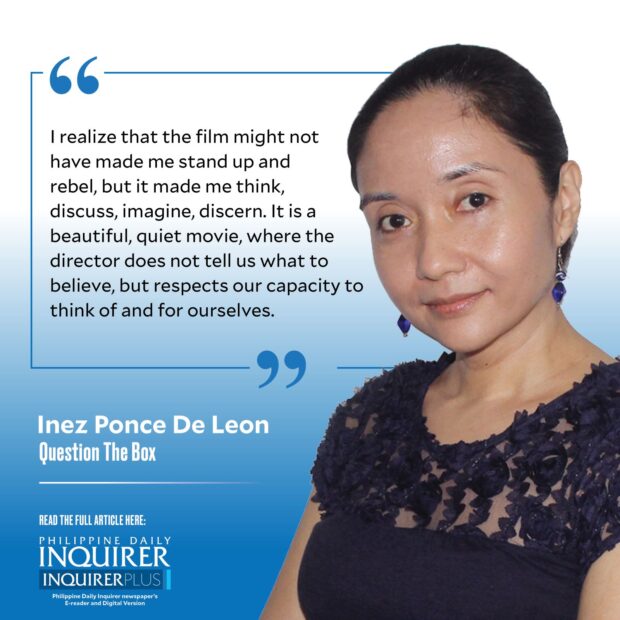
At one of Ateneo’s Simbang Gabi Masses, the cast and crew of “GomBurZa” invited the congregation to watch the film. Cedrick Juan, who played Fr. Jose Burgos, promised that the movie would deliver a message of hope. After Mass, the church bells played “Bayan Ko.”
There was some expectation, therefore, of a rousing film—but days after it screened and won numerous awards, a few critics online said that there was something “missing.”
I finally had the chance to watch the movie last week.
“GomBurZa” goes deeper than the journey of the cautious Mariano Gomes, the rebel Burgos, the accidental hero Jacinto Zamora, and their work as priests fighting for local clergy to oversee their parishes. It tells our story: the beginnings of our revolution, where the priests are no mere men in cassocks, but Filipinos—ears closest to the ground, hearts with the people, but deprived of the capacity to lead the parishes that love them, in the same way that we were deprived of our capacity to lead ourselves.
There is, indeed, something missing from the film, but only if one were to expect a “Heneral Luna” event of guns, explosions, and expletives. I admit that I was waiting for a spectacle that would make me stand up in anger, the way that I thought I would when I exited Mass weeks before and hummed along with the church bells.
My colleague Jas Rombaoa, a fellow research instructor, and I discussed the film for hours afterward. We speculated on who the priests seemed to represent: Gomes, the older generation tired of the heartbreaks of oppression; Burgos, the learned younger generation castigated for its courage; Zamora, the people caught in the fray, those abused without knowing it, the victims of extrajudicial killings who want no part in the violence but who are held up as examples of sin by an abusive, paranoid state.
We shifted to comparisons between leaders then and today, and then parallels in history, and then different levels of oppression. We both marveled at Enchong Dee’s depth of portrayal of the lost, catatonic Zamora, while we reflected on his focus on candlelight, as though he were seeking something he could not articulate, something that his fellow prisoner-priests spoke of lucidly as “liwanag.”
It is not merely a light that Zamora seeks, that we all wait for. Liwanag is illumination, enlightenment, hope at the end of long suffering.
I even proposed a recut of the ending: as the garrote is being turned on Father Burgos, the scene cuts to the red-lit montage of our heroes to come: the revolutionaries, Rizal and his books, the smoke of war and the shouts of rebellion—all of it a mere dream in the eyes of a dying man. We fade to Burgos slowly raising his tied wrists, then cut to the words of the epilogue. The screen of words dissolves into fire, into the sunlight that pierces through the space between Burgos’ tied wrists as they reach their highest point with his last breath. It is a final play between light and illumination, between the darkness that was and the dreams to be.
“Vivan Los Filipinos,” the voice-over says.
We sharply cut to black, and the voice-over asks: Vivan?It invites the audience to speak, to respond whether we, indeed, can celebrate being Filipinos when we remain silent in the face of injustice.
I still think about the film, and its imagery and implications, days later. As I sit and write, I realize that the film might not have made me stand up and rebel, but it made me think, discuss, imagine, discern. It is a beautiful, quiet movie, where the director does not tell us what to believe, but respects our capacity to think of and for ourselves.
It asks us to critique the idea of single, one-shot solutions. In the film, it’s the isolated revolutions, mutinies, and meetings, all of them believing that one rebellion alone can push us out of slavery. Progress, however, arises from writing, arguing, realizations; it takes years of planning and cooperation to finally bring us the change that we want. Even Rizal’s novels and their narratives of failed, personal-vendetta revolutions cautioned against the notion that a single attack could topple the oppressors, let alone change the hearts of the afraid.
It is a film that makes us examine our solutions today: the bombs that wipe out lives and yet purport to target terror; the obsession with changing a constitution and selling the idea as the single answer to the nation’s ills.
It is a film that does not shout at us to fight but invites us to first imagine what it is we are fighting for.
What is missing? Perhaps what is missed, instead, is a society that values questioning, reflection, discussion.
The movie isn’t missing it; but we, as the audience, perhaps miss the time when we were a discerning people, a thinking people, a people whose hearts were firmly planted in history.
Judging from the box office draw of “GomBurZa,” its multiple awards, the buzz online—perhaps that audience is slowly coming back.
Perhaps the Filipino, whole in mind and heritage, will no longer be missing.
And, to that: VIVA.
iponcedeleon@ateneo.edu

